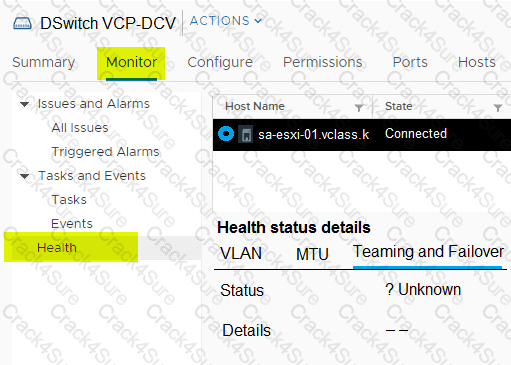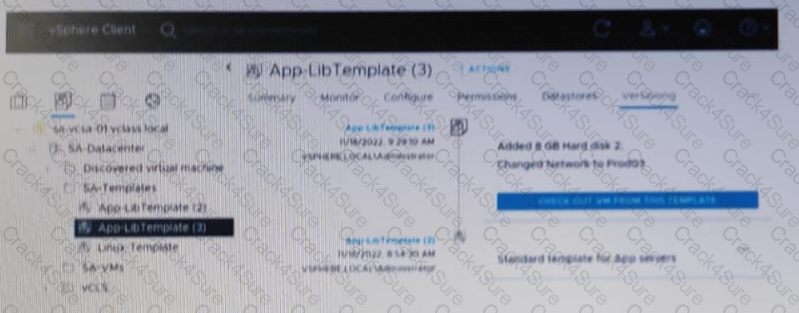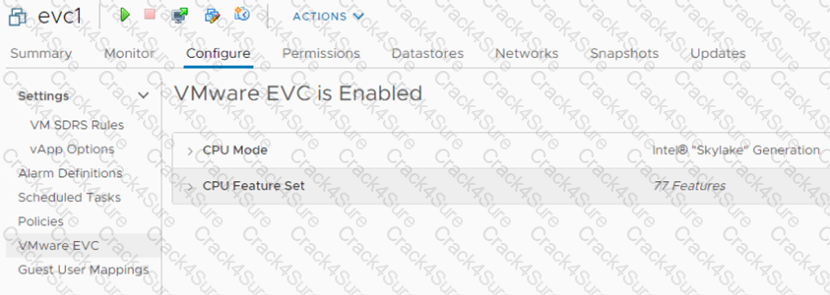We at Crack4sure are committed to giving students who are preparing for the VMware 2V0-21.23 Exam the most current and reliable questions . To help people study, we've made some of our VMware vSphere 8.x Professional exam materials available for free to everyone. You can take the Free 2V0-21.23 Practice Test as many times as you want. The answers to the practice questions are given, and each answer is explained.
An administrator notices a performance issue in VMvvare vCenter To try and understand more about the performance issue, the administrator needs to gather more information about the vCenter database to eliminate a potential disk space issue.
Which two tools can the administrator use? (Choose two.)
An administrator is creating a content library to manage VM templates and ISO images. The administrator wants to password-protect the images and templates and share them with a remote site.
Which two tasks must the administration perform when creating the content library? (Choose two.)
An administrator needs to perform maintenance on a datastore that Is running the vSphere Cluster Services (vCLS) virtual machines (VMs).
Which feature can the administrator use in this scenario to avoid the use of Storage vMotion on the vCLS VMs?
An administrator wants to allow a DevOps engineer the ability to delete Tanzu Kubernetes Grid (TKG) cluster objects in a vSphere Namespace.
Which role would provide the minimum required permissions to perform this operation?
An administrator notices a Fibre Channel adapter in an ESXi host has been experiencing inconsistent connectivity states.
Which trigger can be used to quickly identify the issue and alert the administrator so that the issue can be resolved?
Which feature would allow for the non-disruptive migration of a virtual machine between two clusters in a single VMware vCenter instance?
An administrator is responsible for the management of a VMware vCenter instance that is currently experiencing performance issues. The administrator quickly identifies that the CPU and memory utilization of vCenter is consistently over 80%. Upon further analysis, it seems that the vpxd process is contributing significantly to the performance issue.
A combination of which four steps should the administrator take to resolve the performance issues and ensure that a similar issue can be rectified without requiring downtime to vCenter moving forward? (Choose four.)
During the staging of a patch on a vCenter Server Appliance, an error was encountered and the process stopped. An administrator resolved the root cause and is ready to continue with the staging of the patch.
From the vCenter Management Interface, which action should the administrator take to continue the process from the point at which the error occurred?
An administrator wants to create virtual machine (VM) templates and store them in a content library. The administrator would like to use the content library to manage different versions of these templates so that reverting to an earlier version is an option.
How should the administrator create these templates?
An administrator plans to bring VMware vCenter offline in order to perform hardware mainte-nance on the host where the vCenter Server Appliance is running.
Which vSphere feature must be configured to ensure that vCenter users experience minimal downtime?
Following a merger with another company, an administrator is tasked with configuring an identity source for VMware vCenter so that all vSphere administrators can authenticate using their existing Active Directory accounts. Each company has user accounts in their own Active Directory forests.
The following additional information has been provided:
• The corporate policy states that only Windows-based machine accounts are allowed in Active Directory. Which action should the administrator take to configure vCenter Single Sign-On (SSO) to meet this requirement?
The vCenter inventory contains a virtual machine (VM) template called Linux-01. The administrator wants to install a software patch into Linux-01 while allowing users to continue to access Linux-01 to deploy VMs. Which series of steps should the administrator take to accomplish this task?
An administrator is completing the configuration of a new vSphere cluster and has enabled vSphere High Availability (HA) and vSphere Distributed Resource Scheduler (DRS).
After adding the ESXi hosts to the cluster, which networking information will the administrator be prompted to provide when using the Cluster Quickstart workflow?
What is the minimum network throughput in Gb/s for vSAN using the Express Storage Architecture (ESA)?
Which step is completed during Stage 1 of the vCenter Server Appliance deployment?
A vSphere cluster has the following configuration:
• Virtual machines (VMs) are running Production and Test workloads
• vSphere Distributed Resource Scheduler (DRS) is enabled
• There are no resource pools in the cluster
Performance monitoring data shows that the Production workload VMs are not receiving their fully allocated memory when the vSphere cluster is fully utilized.
A combination of which two steps could the administrator perform to ensure that the Production VMs are always guaranteed the full allocation of memory? (Choose two.)
An administrator has a host profile named Standard-Config. The administrator wants to change the other host profiles to use only the storage configuration settings that are defined in the Standard-Config host profile.
What should the administrator do to make this change?
An administrator is tasked with deploying a new on-premises software-defined data center (SDDC) that will contain a total of eight VMware vCenter instances.
The following requirements must be met:
• All vCenter instances should be visible in a single vSphere Client session.
• All vCenter inventory should be searchable from a single vSphere Client session.
• Any administrator must be able to complete operations on any vCenter instance using a single set of credentials.
What should the administrator configure to meet these requirements?
Exhibit switch

An administrator configures a distributed switch and adds the first VMware ESXi server to it.
The administrator also performs the following activities:
•The administrator assigns two uplinks to the distributed switch.
•The administrator enables uplink teaming.
When attempting to perform a health check of the teaming policy, the health status of the Teaming and Failover reports as ' Unknown?, as seen in the exhibit.
What can the administrator changes in the distributed switch for the health status to report correctly?
An administrator needs better performance and near-zero CPU utilization from the ESXI hosts for networking functions and processing. The administrator creates a new vSphere Distributed Switch and enables network offloads compatibility.
Which solution would help achieve this goal?
An administrator has configured Storage I/O Control (SIOC) on a Virtual Machine File System (VMFS) datastore.
•The datastore supports 30,000 IOPS
•Storage I/O Control has been set to manual
•Storage I/O Control is triggered when latency hits 30 ms
•The datastore contains 3 virtual machines (VMs)
•A gold tier VM
•A silver tier VM
•A bronze tier VM
Assuming the datastore latency does not exceed 29ms, what is the maximum number of IOPS the bronze tier VM is entitled to?
When configuring vCenter High Availability (HA), which two statements are true regarding the active, passive, and witness nodes? (Choose two.)
Refer to the exhibit.

Given the configuration shown in the exhibit, what must the administrator do to delete only the latest version of the template?
A VMkernel port is labelled PROD01 and uses the default TCP/IP stack. Currently, this VMkernel port is configured for supporting live virtual machine (VM) migrations.
Which configuration change should the administrator make to isolate live VM migration traffic from other network traffic?
An administrator is asked to segregate virtual machine (VM) traffic by VLAN on a vSphere standard switch The following requirements must be met:
•VLAN ID on the switch port group must be 4095.
•VLAN tagging must be done at the VM level.
Which tagging mode is required?
Refer to the exhibit.

An administrator is tasked with adding new capacity to an existing software-defined data center (SDDC).
• The SDDC currently hosts two vSphere clusters (ClusterA and ClusterB) with different CPU compatibilities.
• vSphere vMotion and vSphere Distributed Resource Scheduler (DRS) are currently in use in the SDDC.
• The new capacity will be implemented by provisioning four ESXi hosts running a new generation of Intel Skylake CPUs.
• All workload virtual machines (VMs) must support live migration to any cluster in the SDDC.
The administrator noticed the running critical "ever virtual machine (VM) shown in the exhibit is not migrating using vSphere vMotion to the original Clusters A or B.
Which three steps must the administrator take to support this functionality? (Choose three.)
An administrator creates a virtual machine that contains the latest company-approved software, tools and security updates. Company policy requires that only full clones are allowed for server workloads.
A combination of which two tasks should the administrator complete to prepare for the deployment of this virtual machine for multiple users? (Choose two.)
3 Months Free Update
3 Months Free Update
3 Months Free Update